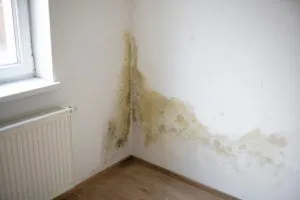
Indoor air quality is a growing concern throughout the U.S., especially as building envelopes (the structure that seals your home or business) continue to become more and more airtight. While that can be a good thing, it can lead to less airflow, and without proper methods to ensure proper air cleanliness, it can lead to numerous health consequences. How do mold and mildew impact indoor air quality, then?
How Mold and Mildew Spread in Homes
A leaking faucet under the basement sink may not seem like a whole home problem, but that is not the case if that leak persists. It can easily create the development of mold or mildew, both of which can grow unnoticed for months behind drywall or under carpeting. When any type of airflow occurs, it can pick up on the tiny mold spores and whisk them throughout your home, allowing for the mold to spread just about anywhere it lands.
However, this is made worse if the spores get into your home’s heating and cooling system, where they can spread to virtually any room of the home connected to a vent. That means that a wet spot in the basement could be causing mold to spread into your kitchen, bathroom, and bedroom, and you do not know it is happening. Over time, this can create a whole-home problem.
At Ambient Edge, we work closely with our clients to ensure they have proper measures in place to prevent this, including whole home air cleaners that can minimize the risk of mold spread. We can also help you to maintain your home’s heating and cooling system properly, ensuring that it is going to encourage healthy airflow. That in itself can help to reduce the risk of health complications.
Know the Signs of a Mold Problem in Your Home
If your home has any area that is musky smelling or there are people in the home that seem to always have a cough, these are signs that you could have mold or mildew present in the home – even if you do not see it. Long-term exposure to mold and mildew can create serious problems for many people, even those who do not have asthma or allergies, including lung infections and, over time, chronic bronchitis. If there is a risk of respiratory distress in your home, make sure any mold problem is handled right away.
How Improving Air Quality Plays a Role in Your Health
Noting that mold and mildew can impact overall indoor air quality, there are several steps you should take now that can help you find relief and minimize the risk of those types of health complications. Start by having your home’s air quality tested, which can determine if there are significant risks present that warrant immediate attention and care. An indoor air quality test can be something you invest in yearly if you have people in your home at risk for respiratory complications, immune deficiency conditions, or other conditions.
Next, work with your team to find and clean away any mold that is noted to be present. Typically, this involves a mold remediation process when it has spread to various areas of the home. Though a somewhat complicated process, if you have mold or mildew present, the only way to protect your home and family is to have this type of process taken care of right away.
Then, improve the air quality in your home with the help of a whole home air cleaner or other types of air filtration systems. Our team at Ambient Edge can offer recommendations that can provide you with the relief you need as they work to circulate air properly. With proper air circulation, you will see less mold and mildew develop, and that means less spread for you to have to worry about going forward.
What Factors Increase Your Risk of Mold and Mildew in Your Home?
There are many times when you simply should not put off getting help for mold and mildew, such as if your air quality tests indicate a high level of risk and exposure. There are other times when it is also critical that you address mold and mildew concerns, especially when there are high risks present that these organisms can develop. While mold and mildew are present in most homes at lower levels, bigger problems exist in some situations.
If your home is older and has a wet basement, which may mean any amount of moisture buildup present, that will significantly increase the risk of these organisms developing. Look for signs of this, such as discoloration on ceiling tiles, musty-smelling areas of the home, and areas where you see mold formations on the surface of walls, carpeting, and other furnishings. You may notice what looks like fuzzy material spreading on the surface, or, in some situations, you may notice mold growth as just a black or brown discoloration.
Your home may also be at a higher risk of mold and mildew growth if the humidity level is high, such as if you do not use the air conditioner often. If the landscaping around your home does not drain well, this can allow moisture to penetrate into the structure’s foundation, causing a difficult-to-see presence of water that could lead to mold. These are just a handful of the most common reasons mold and mildew are present, but note that you may not always see it or know it is there.
Let Our Team Help You with Your Indoor Air Quality Now
Our professionals at Ambient Edge can offer the help and guidance you need to overcome the challenges of mold and mildew in several ways. Allow our team to provide you with careful cleaning and maintenance of your home’s heating and cooling system, including the ventilation system, so as to minimize the movement of mold.
We would be happy to discuss the benefits of an indoor air cleaning system with you, including a whole home cleaning system that can also help reduce your risks, so be sure to call us today.


